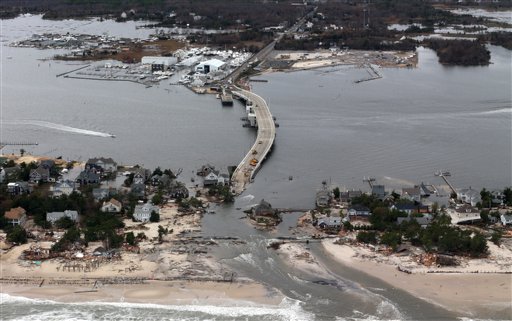(AP) Battered NJ agonizes over whether to rebuild shore
By GEOFF MULVIHILL and MARYCLAIRE DALE
Associated Press
LONG BEACH TOWNSHIP, N.J.
In its tear of destruction, the megastorm Sandy left parts of New Jersey’s beloved shore in tatters, sweeping away beaches, homes, boardwalks and amusement parks.
The devastation left the state a blank canvas to redevelop its prized vacation towns. But environmentalists and shoreline planners urged the state to think about how _ and if _ to redevelop the shoreline as it faces an even greater threat of extreme weather.
The sea level is rising fast, and destructive storms are occurring more frequently, said Williams, who expects things to get even worse.
He and other shoreline advocates say the state should consider how to protect coastal areas from furious storms when they rebuild it, such as relocating homes and businesses farther from the shore, building more seawalls and keeping sand dunes high.
How to rebuild after the disaster is becoming an issue even as New Jersey assesses its damage.
The state’s death toll from Sandy climbed to at least 14, 2 million customers remained without electricity and earth-moving equipment made its way for the first time to hard-hit barrier island communities.
National Guard members went door-to-door on Long Beach Island to check on survivors and delivered supplies to heavily flooded Hoboken. President Barack Obama, skipping campaign appearances, came to New Jersey to see the damage.
In Hoboken, a one-square-mile city on the other side of the Hudson River from New York City, at least 25 percent of the community was flooded and 90 percent was without power. National Guard troops delivered food and water as officials sent out a plea for boats and generators.
Most passenger trains were still suspended, lines were long at gas pumps, and Halloween celebrations were postponed. But there were some steps toward normalcy: many schools planned to open on Thursday, state workers were told to return to work and most New Jersey Transit buses were to resume service.
The state’s main focus was at the storied Jersey Shore, where houses were thrown from their foundations and parks and beaches were partially destroyed.
In his evening briefing Wednesday, Gov. Chris Christie reiterated that he wants to rebuild.
But the governor said homeowners in hard-hit areas should decide for themselves whether they want to rebuild or sell their property to the state for conservation.
The government, the Republican governor said, should not decide where rebuilding is and is not allowed.
New York Gov. Andrew Cuomo, a Democrat, disagreed Wednesday, saying that rebuilding after Sandy should include new ways to prevent damage from future hurricanes and storms.
Shoreline advocates say there are three ways to protect the shore from extreme weather: build more jetties and seawalls, keep beaches replenished and relocate homes and businesses.
The physical solutions can help protect homes and roads, but also cut off access to the beaches or water. New Jersey is known for having a lot of protective barriers.
The U.S. Army Corps of Engineers says it’s moved more than 65 million cubic yards of sand for replenishment projects in New Jersey. The state government has done additional projects without federal assistance.
Environmentalists say moving sand can cause harm to the areas it’s moved from, and might not be a good match for its new location. The supply of usable sand also is limited, they say.
Still, it seems to work. Some residents on Long Beach Island on Wednesday credited high dunes and wide beaches built as part of replenishment efforts there for keeping destruction from being even worse.
The northern barrier island that suffered the worst damage from Sandy is the longest developed stretch of New Jersey’s 127-mile coastline without the help of federal replenishment projects.
The federal government pays for much of the beach protection programs. Including state and local contributions, shore protection programs with federal involvement from Manasquan to Cape May have cost taxpayers $475 million since 1988.
Peter Kasabach, executive director of the planning advocacy group New Jersey Future, says that subsidy, along with federal flood insurance that encourages rebuilding, is problematic.
He suggested bans on building in some sensitive beach areas, or requirements that homes be built farther from the ocean.
The Surfrider Foundation’s Nelsen said he hopes that New Jersey communities at least consider rebuilding in different places, which he said has never been done on a large scale in a U.S. oceanfront.
___
Follow Mulvihill at http://www.twitter.com/geoffmulvihill.
___
Mulvihill reported from Trenton, N.J. Associated Press writer Wayne Parry in Mantoloking contributed to this report.

COMMENTS
Please let us know if you're having issues with commenting.